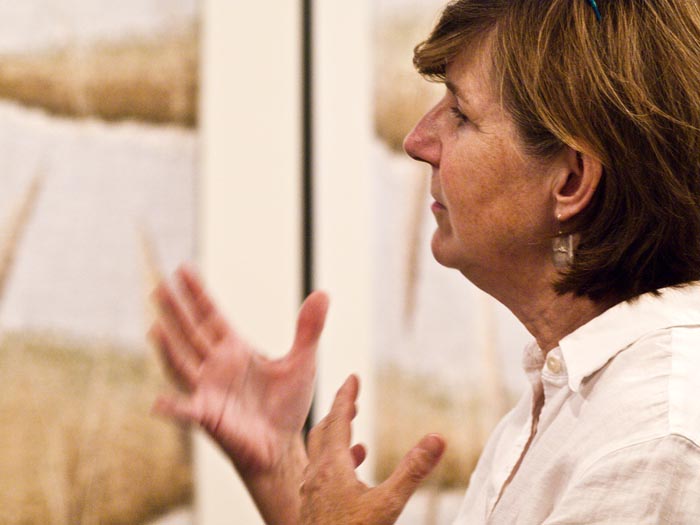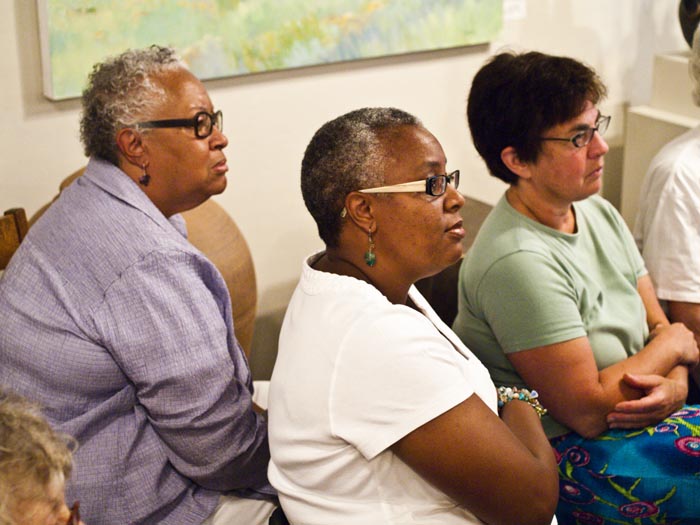Even for an established weaver with 45 years of experience, it seems the essence of tapestry art is best explained by the reaction of an outsider to the art. While at a tapestry show in Philadelphia, Julia Mitchell witnessed the raw and pure reaction to her craft. A man passing by stopped in front of one of her woven linen tapestries and gawked momentarily before approaching the piece. Then he took the cloth in his hands, thrust it to his nose and sniffed deeply.
“I didn’t know whether to laugh or cry,” Ms. Mitchell recalled. But last Tuesday night in the intimate setting of the Shaw Cramer Gallery in Vineyard Haven, the artist opted to laugh and admit, “That [reaction] said it all.”
During her talk entitled Why Tapestry, Ms. Mitchell stressed that weaving is not like painting or drawing, nor is it a three-dimensional art form like sculpting. “You mix your palette on and in the tapestry. The results are images that can only be woven.”
And it is just this mystery and majesty that draws many amateur weavers to Ms. Mitchell’s weaving classes on the Island. But in terms of why tapestry, even Ms. Mitchell is often at a loss for words. She began her talk discussing its counterpart, why not tapestry?
In terms of the “why nots,” Ms. Mitchell was honest with her assessment. For one thing, behind every great weaver is a great chiropractor. Weaving is a strenuous task, and remarkably time consuming.
“People are always telling me, ‘you must be so patient,’ but it’s not a matter of simple patience. Weaving is tedious.”
It’s also expensive and, like any other freelance art, it can be a bit of a rough business. The materials are all organic and high quality, but are difficult to come by due to the rarity of the craft and the need for particular yarns. Ms. Mitchell works primarily with linens, which is unique among modern weavers who generally use cotton. Such yarns are, as Ms. Mitchell put it, “an anachronistic medium,” and weaving itself is a little known art form that can often be seen as archaic. But it was in the deep-rooted history of the craft that she began to answer the question, why tapestry. People have been making tapestries since the Third Century, B.C. “Weaving is in our bones,” Ms. Mitchell said.
The art met its “heyday” in the Middle Ages in Europe, where tapestries adorned castle walls and illustrated magical and miraculous scenes in hues of vibrant color and accent threading made of gold. Many of these medieval tapestries continue to survive today. Ms. Mitchell attributes this fact to the “durability and flexibility of tapestries.”
And yet perhaps the most outstanding quality of tapestry can be explained by the overeager sniffer at the Philadelphia Art Show.
“People are physically, inherently drawn to tapestry,” said Ms. Mitchell. “They seem familiar because the product is cloth, something humans have cherished since they stopped wearing animal skins.”
The warm and tangible quality of a finished tapestry helps answer the question of why tapestry for the viewer, but for the artist there is a different type of unique and emotional experience. The creation of any one of Ms. Mitchell’s tapestries takes months. The finished product begins as nothing more than a series of thumbnail sketches on the artist’s desk.
“I draw tons of thumbnails, absolutely tons,” she said. “Then I may move to 8 x 10 paper. My drawings evolve and they morph and combine, and things just happen.”
Though she only weaves one tapestry at a time, Ms. Mitchell works on multiple designs at once.
But even before the sketches are made there is yet another part of the process, the period of inspiration. For Ms. Mitchell the Vineyard itself is her constant inspiration, but it is not a new source.
“I grew up right next door to Cedar Tree Neck, in a conclave of old houses... That’s my hunting ground [for inspiration] from my childhood. I know it like the back of my hand.”
Sure enough, the vast majority of the featured tapestries at the Shaw Cramer Gallery were, in her words, “Vineyardy” with oceanic color schemes and meadow scenery.
The tapestries hanging in the gallery, along with the pictures of ancient work passed around by Ms. Mitchell, testified to the fact that weaving is an uncommon craft. The craftsmanship required to blend colors and scenes by weaving strands of thread on such an impressive scale is rare, but the results are far too affecting for this art ever to disappear. Ms. Mitchell is certainly not worried.
Near the end of her talk she smiled and said, “It’s a small but mighty cohort of people around the worldand we’re very active.”
In September Julia Mitchell will guest curate an invitational fiber exhibition entitled The Art of Fiber taking place at the Featherstone Center for the Arts in Oak Bluffs. The exhibit will run from Sept. 18 through Oct. 5, with an opening reception on Sept. 18 from 4 to 6 p.m.
Artists featured in the exhibit include Linda Behar, Ethel Stein, Lucy Mitchell, Peigi Cole-Joliffe, Nancy Shaw Cramer, Michele Ratté , Darlyn Susan Yee, Kari Lonning, Julia Mitchell, Amy Nguyen and Eva Gallant.







Comments
Comment policy »